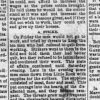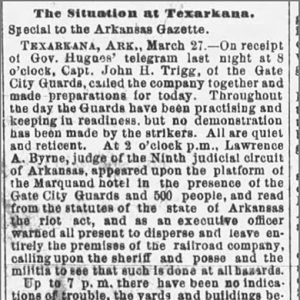calsfoundation@cals.org
Great Southwestern Strike
At its height, the Great Southwestern Strike of 1886 shut down railway lines in five states (Arkansas, Illinois, Kansas, Texas, and Missouri), threatened to upset commerce nationally, and, with its promise of union recognition, attracted support from a wide spectrum of unskilled and semi-skilled railroaders. Instead of winning union recognition, the strikers met with a terrible defeat that divested hundreds of their jobs, confirmed the power of the state and federal governments to repress labor unrest on the railways, and dealt a severe blow to the Knights of Labor, the nation’s largest labor union. Defeat was not total, however; strikers’ grassroots, cross-racial activism on the railroads contributed to the broader Populist movement in Texas and Arkansas.
The Great Southwestern Strike grew out of the volatile history of western railroading. During the late nineteenth century, the railroad industry expanded west and south at a spectacular rate. Railroad workers for a time enjoyed better wages, conditions, and opportunities on labor-scarce western lines, but by the 1880s, many faced managers’ determined efforts to slash labor costs. On the Southwest system, which ran through seven states west of the Mississippi River, labor exploitation took on special significance in that the face of management was railway “king” Jay Gould, a man widely reviled as a ruthless monopolist and destructive speculator. By the early 1880s, Gould commanded the Missouri Pacific; the International and Great Northern; the Wabash, St. Louis and Pacific; the St. Louis and Iron Mountain; and the Missouri, Kansas and Texas. This network linked Texas with the East and North and allowed Gould control over “nearly all the railroads entering from the West,” according to historian Maury Klein.
In the wake of a series of cost-cutting policies, railroad workers along Gould’s Southwest system launched a strike in March 1885 that crossed lines of skill, race, and ethnicity and succeeded in winning large-scale public support and significant concessions. The relatively inclusive Knights of Labor took hold in the region, forcing the system into a compact promising strikers that they would be hired back without prejudice, paid the wages they had received prior to a series of wage cuts, given thirty days notice of any reduction in wages, and compensated time-and-a-half for overtime work. However, Gould system officials routinely and blatantly violated the 1885 compact. When Gould’s Wabash railroad cut wages without notice and practiced discrimination against Knights, the national Knights threatened a national railroad strike, forcing Gould himself to the bargaining table in August and September 1885. The conditions for peace included the company’s reinstatement of strikers, a pledge to end discrimination, and a commitment on the part of national Knights head Terence Powderly to hold a conference with railroad officials before calling another strike. Yet Gould system officials widely ignored the terms of both 1885 agreements. In a typical case, one Knight in Arkansas testified later that he often worked thirteen-hour days for ten hours’ pay and received a pay cut from $1.50 to $1.25 per day. In this context, District Assembly 101 of the Knights of Labor ordered a strike on March 1, 1886, on the Texas and Pacific after a foreman in Marshall, Texas, fired Charles A. Hall, a local Knights leader. For many, Hall’s case underlined the need to institutionalize workers’ voice on the railways. A mass walkout of shop workers on the Missouri Pacific followed on March 6. Two days later, the St. Louis Post-Dispatch headlined, “Traffic Throttled: The Gould System at the Mercy of the Knights of Labor.”
In contrast to the March 1885 walkout, however, the 1886 strike lacked the active, sustained backing of skilled trainmen, raised a much more controversial issue than the imposition of “starvation wages,” and seriously disrupted the region’s economy. In Arkansas, residents of Texarkana (Miller County), Hope (Hempstead County), Little Rock (Pulaski County), and other towns saw business idled for three weeks by walkouts on Gould’s St. Louis, Iron Mountain and Southern Railroad. Strikers went beyond the use of moral suasion to engage in militant, direct action, such as the occupation of roundhouses and yards; the physical intimidation of strikebreakers; the assumption of control over locomotive engines; and the disablement, removal, or destruction of equipment. In Little Rock, machinist and Knights leader J. L. DeLay quit work with about 300 shopmen. Although county officials initially deputized DeLay and other Knights to guard railroad property, masked men succeeded in putting numerous engines out of action by removing parts. Large crowds of strikers seized and stole away engines, while more than a dozen “coffin notices” surfaced threatening or warning strikebreakers and railway officials of impending danger if they continued to thwart the walkout.
The courts issued injunctions against such tactics as well as any peaceable strike activity, and skilled trainmen refused to cooperate with strikers. Law-and-order leagues organized in town after town in an effort to restore freight traffic and social stability, including in Texarkana, where a committee of “citizens” retook the shops in late March. Against the wishes of the national Knights leadership, a number of Knights, including Martin Irons, the strike’s chief organizer, pushed for the strike’s expansion nationally and advocated, it seems, the use of violence against strikebreakers. Bloody clashes between pro-strike crowds and company-hired deputies in Fort Worth, Texas; East St. Louis, Illinois; and elsewhere left at least nine dead and dozens wounded. Strikers exchanged heavy fire with deputies outside of Little Rock in mid-March after commandeering an engine, and again on April 8 when forty to seventy-five Knights approached deputies guarding the shops and demanded that they leave. By May, freight traffic had resumed; the Knights were under siege; and a movement among townspeople, editorialists, and many former strikers blamed the ordeal of the walkout on Irons, who had gained public notoriety for his embrace of violence, his alleged drunkenness, and his rocky marital history.
The Knights’ defeat notwithstanding, the struggles of 1885 and 1886 produced a biracial alliance among both black and white Gould system railroaders. While fragile and limited, it drew on workers’ common hostility to monopoly, labor exploitation, and the employment of Chinese and convict laborers, sentiments also shared by the mass of urban workers and farming people across the region. In Little Rock, many black Knights and a number of white Knights—particularly the Knights’ state organizer, Dan Tomson—allied in July 1886 to support a strike by black cotton-pickers reputedly led by Hugh Gill, outside the city. White and black Knights went on to do significant work in such populist groups as the Agricultural Wheel and the Union-Labor Party in the mid- and late 1880s.
For additional information:
Case, Theresa A. The Great Southwest Railroad Strike and Free Labor. College Station: Texas A&M University Press, 2010.
———. “The Radical Potential of the Knights’ Biracialism: The 1885–1886 Gould System Strikes and Their Aftermath.” Labor: Studies in Working Class History 4 (Winter 2007): 83–107.
Hild, Matthew. Greenbackers, Knights of Labor, and Populists: Farmer-Labor Insurgency in the Late-Nineteenth-Century South. Athens: University of Georgia Press, 2007.
Turner, Ralph V., and William Warren Rogers. “Arkansas Labor in Revolt: Little Rock and the Great Southwestern Strike.” Arkansas Historical Quarterly 24 (Spring 1965): 29–46.
United States Houses of Representatives, Select Committee on Existing Labor Troubles. Investigation of Labor Troubles in Missouri, Arkansas, Kansas, Texas, and Illinois. Part 2. 49th Congress, 2nd session. Washington, DC: Government Printing Office, 1887.
Theresa A. Case
University of Houston-Downtown
 Post-Reconstruction through the Gilded Age, 1875 through 1900
Post-Reconstruction through the Gilded Age, 1875 through 1900 Tate Plantation Strike of 1886
Tate Plantation Strike of 1886 Great Southwestern Strike Article
Great Southwestern Strike Article 



Comments
No comments on this entry yet.